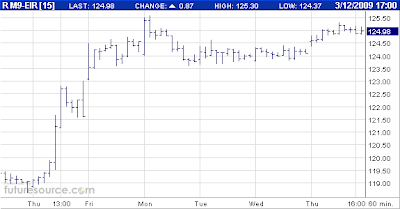I know that the whole QE thing has been done to death, but it's important to try and understand it, which many clearly don't. Here is a bit of economic numptiness from today's FT:
The Bank [of England] was pleased with the result of the so-called reverse auction, in which investors sell their bonds rather than buy them from the authorities. It augurs well for the rest of the programme, in which the Bank aims to buy up to £75bn in gilts over the next three months. It was inundated with £10.5bn of offers to sell gilts – five times more than its £2bn target, quashing initial worries from some City analysts that investors might fail to show up.
The Bank also paid close to the market price for the six bonds, which had maturities ranging from five to nine years, it had offered to buy. There had been worries that it might be forced to pay above market rates as investors demanded a big premium to sell their bonds.
Woah, stop right there! Let's have a look at how the benchmark ten year Long Gilt future shot up in price since QE was announced in earnest last Thursday morning (click to enlarge):
To cut a long story short, the price went up by about five per cent, and has stayed at the higher level. So what the BoE paid on Wednesday may have been 'market value' on Wednesday, but it was five per cent above the market value of a week ago. In other words, for every £1 of new electronic money that the BoE prints, 5p is overpayment, i.e. leads to inflation or combats deflation.
Further, let's not forget the interest rate see-saw:
1. The government can keep long term effective interest rates down by buying up gilts (long term liabilities) with cash (current liabilities). Remember that high gilt prices = low long term interest rates and vice versa. But more cash sloshing around leads to inflation, which leads to higher short term interest rates.
2. Or the government can depress short term interest rates, but this leads to inflation worries, which leads to higher long term interest rates.
3. Or the government can increase short term interest rates to combat inflation, which leads to lower long term interest rates.
And so on, but they are currently playing both ends against the middle, and they do not care any more about anything whatsoever apart from very short term political advantage. It's all well and good knowing a thing or two about economics and finance, but will they stop at £75 billion or £150 billion? The secret of successful speculation is guessing what the government is going to do - those who bought gilts before last Thursday guessed correctly and have reaped the rewards - but how on earth do you predict the actions of a bunch of maniacs?
Thursday, 12 March 2009
NOW! That's what I call market value
My latest blogpost: NOW! That's what I call market valueTweet this!
Posted by
Mark Wadsworth
at
20:37
![]()
Labels: Economics, FT, Fuckwits, Interest rates, Waste
Subscribe to:
Post Comments (Atom)



4 comments:
And if you force up the price of Gilts you reduce the yield and that has an impact on pension fund solvency calculations so that more pension funds go into 'deficit' - but a 'deficit' calculated by the same sort of bonkers calculations that have driven the current Junta to engage in the QE policy.
Really, what can we do with them?
True - NPV of pension fund liabilities go up, but they can sell gilts at overvalue, but then again they can't because rules say they must invest in gilts...
And the notional pension fund deficits are taken as gospel and that pushes down share price of employer company, and that increase deficit in all the other pension funds...
It's not going to work, is it?
A guess is just that, a guess. The only thing you can predict about this lot is that they will fight tooth and nail too keep that trough deep and full.
It's the gold sale in reverse.
Post a Comment